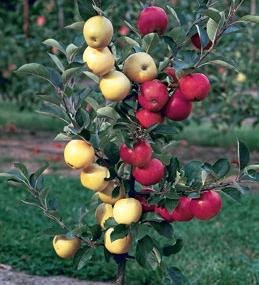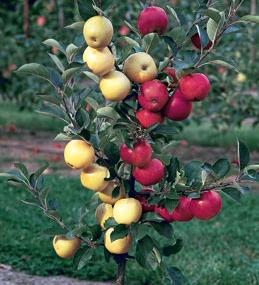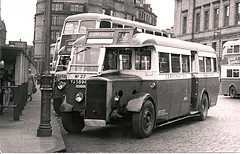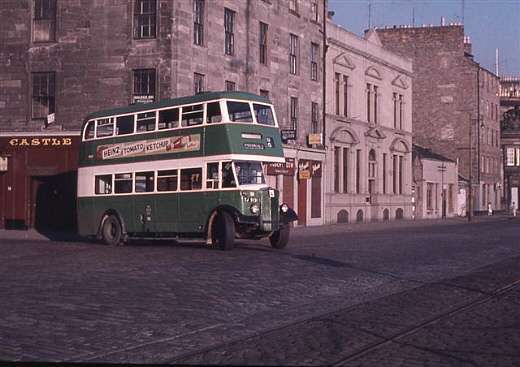
The whole of the poem is in rhyming couplets which makes it sound like a nursery rhyme as this gives it a lyrical feel. There is also a clearly identified protagonist in the first line – Don Miguel – who is clearly on some form of mission which makes this seem like a fairytale.
The poem is about two trees that are first of all tied together by Don Miguel and then separated by an unnamed owner. There are themes here of new life and separation or death. The poem is clearly split into two stanzas, each of these could be said to represent a tree as the stanzas are of equal length just the trees are equal to each other. The trees also form a pair, and throughout the whole poem there are rhyming couplets again highlighting for us the two trees. The storyline also deals with the joining of the trees by Don, this is clearly focused on in the first stanza. This leaves the second stanza free to deal with a later section of time and the separation of the trees – which they manage to survive.
The word choice in lines 4-5 makes clear to us the difficulty of joining the trees. First of all the speaker talks about how “it took him the whole day” suggesting it was strenuous and lengthy work to put the trees together. It also speaks about having to “work” them free from their original spots which again hints at a great effort being put into this task. The difficulty is also suggested in the words to do with pain in lines 5. “lay open their sides” suggests that the trees are in some way exposed, and “lash them tight” suggests that they are having to be held together in a violent way. The “lash” has connotations of being hit with rope or pulled tight.
The kids think the tree is magic because for them it appears as one tree that is somehow able to produce the fruits from two trees. The fact that this is an illusion is given in the expression “looked like”, as the tree is still two separate ones each putting forth their own fruits. The fact that there is a double harvest is given in “double crop” which tells us it provides both lemons and oranges.
Don Miguel is cast as the hero and the man is cast as a villain. This is reinforced through word-choice. At the start of the poem the words are short and have an upbeat effect. We also get a sense that Don Miguel is excessively hard working and enthusiastic about his idea – “Don Miguel got out of bed/ with one idea rooted in his head”. Although it doesn’t say whether this is a good idea or not the lyrical effect of these two lines creates a happy tone and we automatically think that the splicing of the two trees is a good idea.
The man is made to seem like a villain as he remains nameless, he is a shadowy figure in the poem. We are told that he “had no dream” which makes him seem aimless in comparison to Don Miguel. We are then told that his decision to separate the trees is a “dark malicious whim”. The word choice here is very effective at creating a sinister personality for the man as opposed to Don Miguel’s happy persona. His thoughts are “dark” and therefore unwanted and evil. He is called “malicious” suggesting that he aims to cause hurt and finally his actions are perceived as just a “whim” – this is something he hasn’t even bothered to plan out, he is acting spontaneously without thinking about the effect almost as if he is a small child doing whatever he feels like.
The effect of the parallel structure in lines 17-19 is to reinforce that the two trees were not harmed in any way by their separation. This is done with the repeated “no”s at the start of each line and then the unbearable experiences they did not go through – suffering severe loneliness, becoming infertile, suffering from wounds that are incapable of healing properly.
The tone in these lines is didactic and a little sad, the speaker is trying to teach us that despite separation things can survive. The language is quite formal, almost archaic with the use of “nor”, and verging on flowery to create these grand poetic images. This creates an image of a wise person feeding us important information. The language begins with “they did not die from solitude” suggesting that they were not feeling too alone, it continues with the lack of “sterile fruit” again suggesting that they were still able to bear offspring or continue to make produce. There is also the word “flanks” used to describe their open scars from the separation which makes them sound like beasts. It ends on the rather desolate image of “empty, intricate embrace” to describe the trees survival without each other which has left them saddened – their lifes’ are now a little devoid of something, and what they had before was complex, and they provided a comfort to each other.
The final lines of this poem are effective as they challenge the reader to think. It talks about how trees are passive living things – they do not “ache or weep or shout”. This comes after the speaker has suggested that the trees do have human emotions and we would expect the trees to be aching or weeping or shouting. In the final line Paterson’s meaning is ambiguous as he states “trees are all this poem is about”. If this is the case then it is a very simple poem. However, the fairytale structure would suggests that Paterson does actually want us to read a deeper meaning into this story and that there is a moral point here about surviving traumatic separations.





![1-3-5-1-4-2-1-2-2-0-0[1]](https://glow-prod-ea.s3.eu-west-1.amazonaws.com/ea/public/HomeoftheBrave/uploads/sites/1476/2014/09/1-3-5-1-4-2-1-2-2-0-011-300x300.jpg?X-Amz-Content-Sha256=UNSIGNED-PAYLOAD&X-Amz-Security-Token=IQoJb3JpZ2luX2VjEGUaCWV1LXdlc3QtMSJIMEYCIQCCICLdW51uHO9ut%2FE7ibmv3%2FvGeYqImlsH%2BldHvR62vQIhAKpQfgcVDIyvyWRA7yxBp71M9ciOol8xJlBUz0SNkmKeKrkFCC4QBRoMMjczNTcwMTk1NDMzIgzwDBvmzChj2mcly2AqlgXyfOa%2FhNGdoPKKrQc%2B5pA9iJS5yFg08jActvNljKUdWH7MBe2BMIPsQjVCzIFWRQI6XdUf0inM%2B%2B3dzWYB0fpCpn%2FGWPeREJXGdcmpcyBJ7wB8xxxZrS1WOA5YRC4m9ivsrRRcwP5DCAnR9JEZIUs6dwvEvylUXtPA6mvYeHM3glu2zgJLzTT7HrxHB1J%2BdqZKEwZE68nhyu%2B1Xo5eV0c%2BlL%2BwwVS83iR3iFrWED4c%2FAadRmZ4ERiWhk%2BhUdHNiNh3RfpqH%2BH8qKhwptP%2BvMjyU45tRFq%2B3k8h%2BVS4QMpCk%2B6SLSe5LUNRpHT8kfHXnd%2FOmHWz3q7Az6AqrWzqwzMO8AhdySWkVPdvvZgpoOncs%2FEkug6OxaOQhR1%2BbKeImxDrhcqBnirfvaYnDveUasTvyB8cmiKWeDYYhqVWxHmgoECz9Oa5sFv6XuDveeW56Fs0QVe3AAdCl2Q7lshEG2dpjkkU9wQDeNajSeRm9gPWkafN%2BJAgcq1tOW2abZ8Q%2B0EG7BvmyAvqekIwDP2a%2FBRD%2BW9aqxn%2BA6gP3uAR9BFT2uAZc3tbQTH3ZIgEzBDjqBeZf7MJozC4xb0Vhta7dxL6ctjSP7TrrEjYSSzrHHC4bPPR8pdvNt5fIGP1L5CqpTeKCgOhJDc3jMKg8o8%2FwASxHZL%2FKjP%2F8IPpARMfhSjhsCMdA%2Bj5qyRnyb%2BQ4FdCmVmp3qwZix%2FkdAeq4PN6jyZOtjusAmP8bLw5ZVQzbQPKkziBqH7T2p7q16moj8xjJz4J6U5sd8EBsFKv6%2B3YzwltiiO8wOzSOMTzVxQes20olr0utMdaHursreI0gHdtBLQSYzTwaNmefw3P6R8EtYlK6lLUNM1RbNlh4mCiy2lE1mMRQ6ebDjD2o7HKBjqwAadcW0F%2F8YzwGrIhMeRJbSPbiR%2FDTpxSB266t09CXWjldYmHoaJRWdUmf0EYKejOfguS1%2B1SD7oniykEsYWXUZBQVfnoK9sC54G%2B3u1R%2F6LroWhjEtJ9lwixA2Qh9LB7K8VfZhc7RKh%2Bc2xq7Pg2K3Iu1dTm9uiu8Anfb0o6eQmq55ACbvD06EixBhrZObffj%2BB%2FOw%2FDAmnPt7ZoN03kI9Xh%2FJtFJSSdEA0nNQU0QBzl&X-Amz-Algorithm=AWS4-HMAC-SHA256&X-Amz-Credential=ASIAT7MQN47URPUKBLSO%2F20251224%2Feu-west-1%2Fs3%2Faws4_request&X-Amz-Date=20251224T205533Z&X-Amz-SignedHeaders=host&X-Amz-Expires=900&X-Amz-Signature=8a0bda7676837613532a0dce8ceceba635128335692749fae5c27eb1fa82bfb5)





